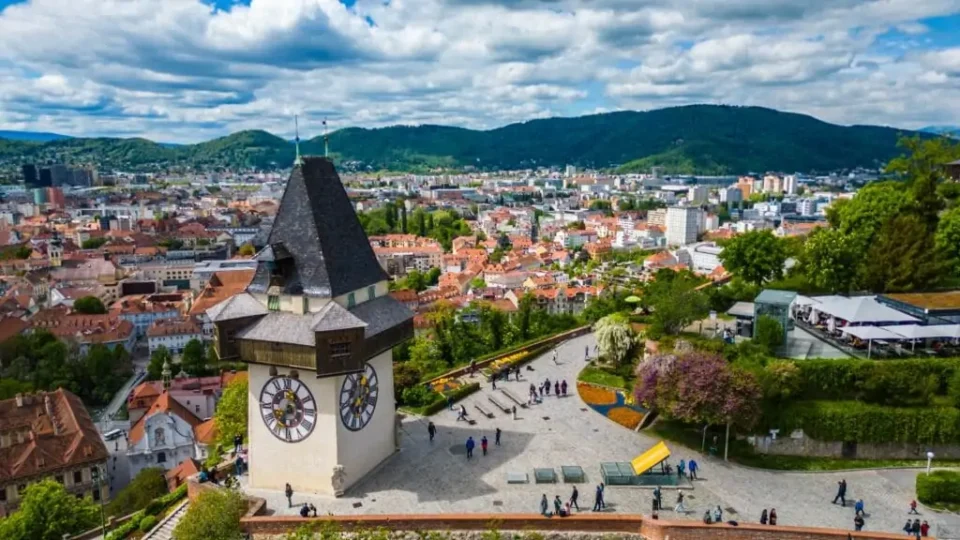The city of Graz (Austria) is the second largest city in the country. Many tourists say that it’s impossible not to fall in love with it – despite its apparent provinciality, there are a lot of young people here, as the city is home to many universities, and student life is vibrant day and night. Graz is also known for its friendly atmosphere, making it feel like a home away from home.
General information
Graz is the capital of the Styria region. Anyone who has visited this city has commented on its diverse character. The streets of Graz are lined with medieval castles, modern skyscrapers, and picturesque villages. The city’s history and modernity are so intertwined that it feels like a set from a time travel movie.

The locals are proud of their ability to harmoniously combine industry and natural beauty, Renaissance-style castles, and modern architectural structures.
An interesting fact! Another reason for the residents of Graz to be proud is that Arnold Schwarzenegger’s sports career began here. The actor spent his entire childhood in the small village of Thal, which is located near the city.
While Vienna is often referred to as the cultural heart of Austria, Graz is known as the student heart. Many tourists remark on the abundance of young people on the city’s streets, which is not surprising given the presence of six universities offering various degrees. According to statistics, students account for one-fifth of Graz’s population.
An interesting fact! According to the mayor of the city, Graz has only recently experienced significant development. The main goal of the city authorities was to preserve the unique medieval architecture while also constructing new, modern buildings.

Tourists will get to know one of the most interesting Austrian cities with its red tiled roofs, beautiful sunsets, wide streets, fairs, festivals, and lively music.
Attractions in Graz, Austria
In small towns, there are usually not many places for tourists to visit. Graz is notable for its high concentration of attractions, making it feel like an open-air museum. The old part of Graz was added to the UNESCO World Heritage List in 1999. It is impossible to see all the attractions in Graz in one day, so many tourists stay for a week. We have compiled a list of the most interesting places in Graz.
Old Town of Graz
Among all the sights of the city of Graz in Austria, the central part is of particular importance. In the past, specifically in the 12th century, Graz was the seat of the Habsburg royal dynasty, and as a result, the old part of the city has been well preserved. The historic center is a cultural treasure not only for Graz but also for the entire country of Austria. The settlement was founded in the 11th century at the foot of Mount Schlossberg, and by the end of the 15th century, it had become a well-fortified city. The central part of the city was used for trade, attracting people from all nearby lands.

An interesting fact! After Graz was the capital of the Roman Empire, its importance increased, and new buildings were constructed, including the Parliament, the Town Hall, and the Arsenal. The residents of Graz are known for their stubbornness, as they refused to allow the demolition of their ancient medieval buildings during the construction of the Town Hall.
Judge for yourself how original and unusual the city center looks, where the surreal Kunsthalle Museum, a monument to tolerance in the shape of a lightsaber, and the floating island of Mur, made of glass and iron, peacefully coexist with ancient buildings. Each of these objects reminds us that despite its thousand-year history, Graz remains young.
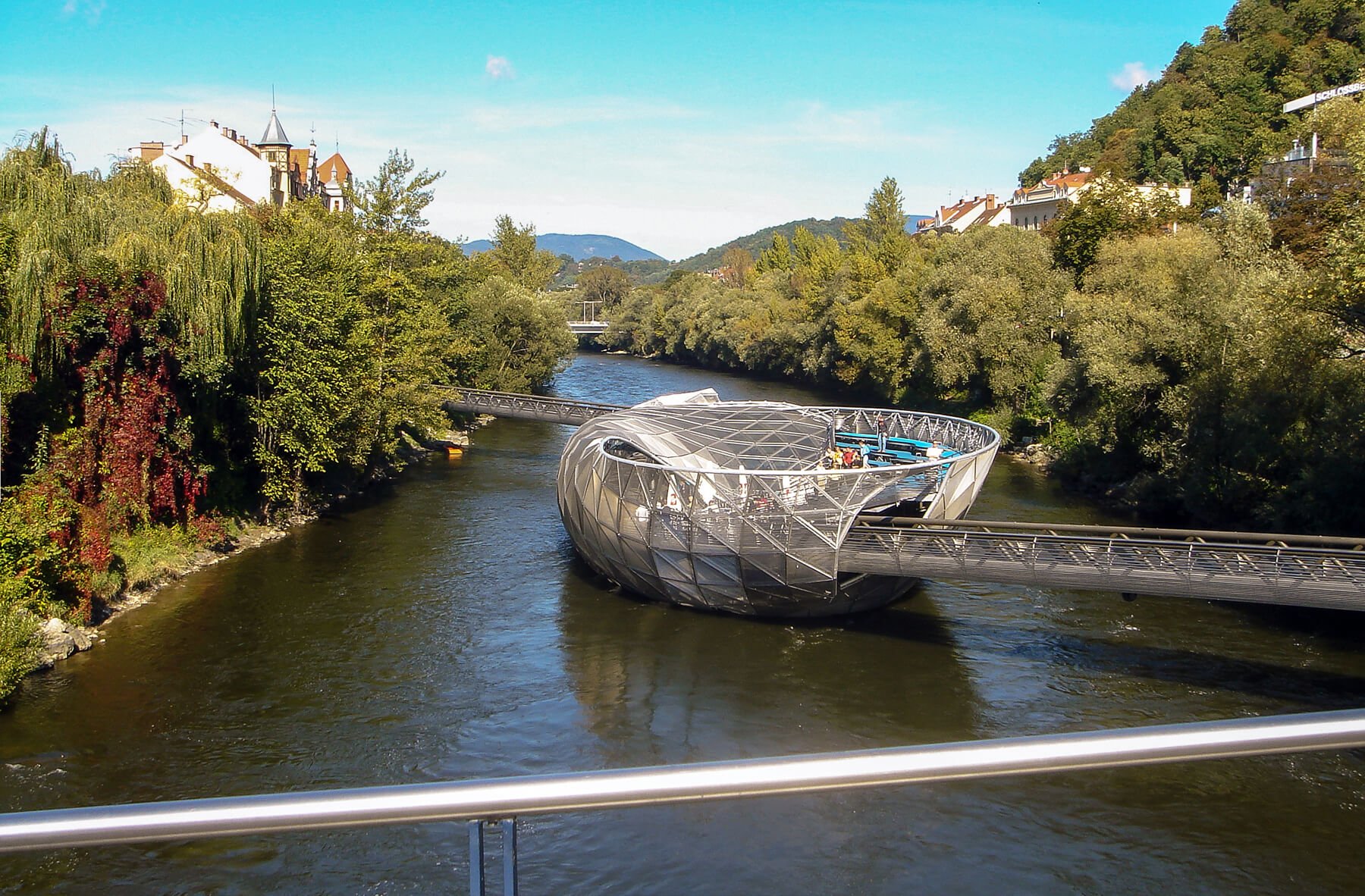
Shporgasse Street
A pedestrian street that crosses the Old Town. It is the longest pedestrian zone and, without exaggeration, one of the most popular among tourists. People come here to walk, absorb the atmosphere of the city, have a leisurely meal, and visit shops and souvenir stalls.

An interesting fact! Sporgasse is an old street, even older than Graz, which was used during the Roman Empire. The name of the street is associated with the fact that during the Middle Ages, craftsmen who made weapons and horse spurs lived and worked here.
Walking along Sporgasse, be sure to look into the courtyards and alleys. Here you can find many interesting places – the headquarters of the Order of Knights, the castle of Saurau. During the day, the street welcomes guests hospitably, and in the evening, all the cafes and restaurants gather young people, from open windows music and cheerful laughter can be heard.
Main Square of Graz
On the Graz map with attractions, the main square is marked as one of the main historical sites. This is the best place to start exploring the city. Different architectural styles are intricately intertwined here. Dozens of streets and small alleys branch off from the main square.

The square is shaped like a trapezoid, and it was founded in the late 12th century by Duke Otakar III. Originally a commercial area, today visitors can explore the city hall, the fountain monument dedicated to Archduke Johann, the Parliament, and the Lugghaus. All the buildings surrounding the square hold historical significance.
An interesting fact! There is still an apothecary on the square, built in the 16th century, and the Hotel is located in the Stürk Palace.

From the point of view of transport accessibility, the square is located very conveniently, as all transport routes pass through it. In addition, an artificial island has been built on the river nearby, connected to the shore by two bridges.
Town Hall
The building is made in the best traditions of German architecture. In the early 19th century, the town hall was completely destroyed, but the efforts of the local residents managed to restore the building. Five years after the destruction, the town hall was again open to the public. Today, this site is included in the UNESCO list of historical heritage.

An interesting fact! The Town Hall is perceived by the city’s residents as an object of socio-cultural significance. It is a talisman of Graz, associated with numerous legends and superstitions.
From mid-November, fairs are held in front of the town hall, and they end the day before Christmas.
The interior of the Town Hall contains unique works of art, including portraits, paintings, coffered ceilings, and tiled stoves. In the southern section, a panel dating back to 1635 has been restored.Schlossberg Mountain and
Schlossberg Castle
This landmark in Graz is also known as the Castle Hill. It is a hill located in the oldest part of Graz, Austria. From here, you can view the city and its surroundings, with the best view from the Urturm observation tower.

There are several ways to climb the tower:
- on foot;
- by elevator;
- on the funicular, which has been operating since 1894.

Locals call the mountain the cradle of Graz, as it was the site of the first settlement. Later, in the 15th century, the castle built on the mountain’s slopes became the residence of the Austrian monarchs. Napoleon attempted to destroy the castle three times, and only succeeded on his third attempt. The citizens of the city paid a large ransom to preserve the bell tower and the Urthurm clock tower.
Today, the mountain is home to a city park, two preserved bastions and a casemate, an exhibition pavilion, bomb shelters, and a cafe.

Attractions on Mount Schlossberg:
- the clock tower is an observation deck;
- a Turkish well built in the mid-16th century;
- The cannon shack used to be a prison, but today it houses a military museum;
- signal guns;
- Cerrini palace;
- a 34-meter-high bell tower;
- the tunnels connect two castles.

Funicular schedule
| Season | Sunday to Wednesday | Thursday to Saturday |
|---|---|---|
| From April to September | From 9:00 a.m. to midnight | From 9:00 a.m. to 2:00 a.m. |
| October to March | From 10:00 a.m. to midnight | From 10:00 a.m. to 2:00 a.m. |
It’s good to know! The area where the fortress is located is currently a park, so admission is free.
Basilica of the Nativity of the Virgin Mary
The attraction is located in the eastern district, at an altitude of almost 470 m. It is one of the largest Catholic pilgrimage centers in Austria. The church is accessed by steep steps, which can be dangerous to climb in winter. The basilica was built in the early 18th century and is decorated in the Baroque style. The church is bright yellow and features towers.

The history of the church is associated with the name of the monk Magnus. The servant of the Benedictine monastery went to distant lands on a religious mission, as a talisman he took a figurine of the Virgin Mary on the road. On the way the monk’s road was blocked by a rock, but the prayer created a miracle and it split. As a token of gratitude, the servant built a small chapel, where he left the figurine of the Virgin Mary.
The interior of the church is richly decorated in the Baroque style. The walls and ceiling are adorned with stucco, paintings, and gilding. The basilica’s true gem is its silver altar.
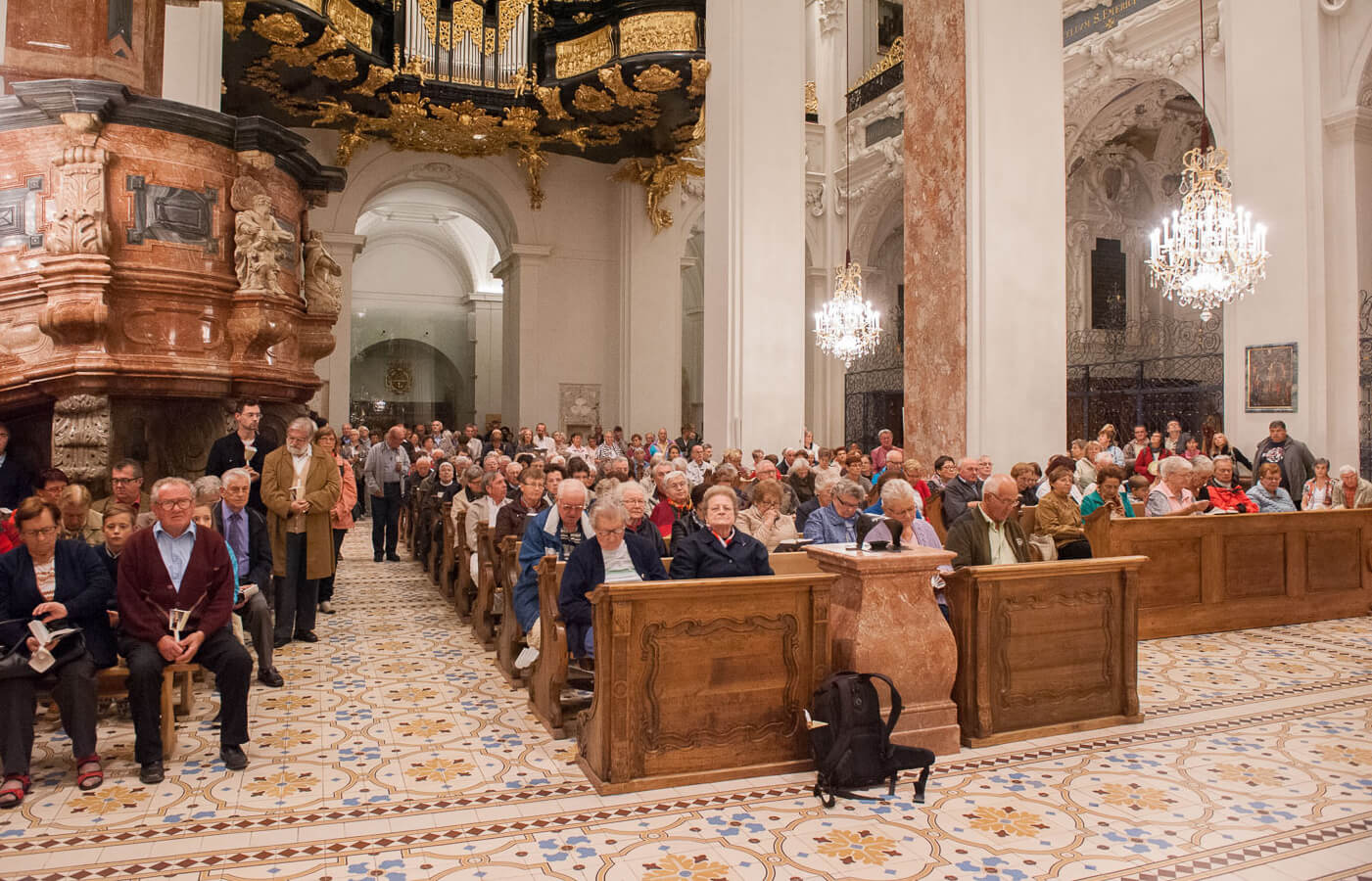
It’s good to know! The Catholic church is also known as the Basilica of Mariazell.
You can get to the Basilica by bus number 552, which departs from WienHbf station several times a day. The journey takes about 3 hours, and the ticket price is around 29$.
Arsenal of Graz
This is one of the main attractions in Graz, Austria, and it attracts thousands of tourists every year. The museum showcases exhibits that tell the story of Austria and its history. The Graz Arsenal is located in a five-story yellow building. The building’s facade is adorned with sculptures of Minerva and Mars, and the central entrance is adorned with the Graz coat of arms.

Local residents cherish military memory, as it is a memory of their ancestors. The museum is not just a place to store weapons and armor; for Austrians, it is a story that tells about their country. With over 32,000 exhibits spread across four floors, the museum is a must-visit for anyone interested in Austrian history. The museum’s collection of weapons and armor is particularly significant, as it reflects the period when Austria was under attack from the Ottoman Empire.
An interesting fact! The arsenal building was constructed in the mid-17th century by the architect Antonio Solari.
Museum exhibits:
- armor and helmets;
- small arms;
- swords, sabers.

The exhibits cover the historical period from the second half of the 15th century to the beginning of the 19th century. The museum displays the entire heroic history of Austria.
Practical information:
- working hours: Monday, Wednesday, and Sunday, from 10:00 to 17:00;
- Ticket prices: adult – 10$, child – 3$.
Styrian Parliament
The Landhaus, or Parliament, was built in Graz in the mid-16th century. Today, it houses the Styrian Parliament. The literal translation of Landhaus means “house and courtyard of the country.” The building and its surroundings are beautifully designed, with a Venetian-style palazzo. During the warmer months, the building and courtyard are adorned with flowers, and in the winter, an ice rink is set up, and an ice manger is installed during the Christmas season.

The interior of the parliament is decorated in the Baroque style. The ceiling in the meeting hall is decorated with stucco, porcelain figures, coats of arms, and the doors are decorated with carvings. The ceiling in the knight’s hall is decorated with intricate stucco paintings, and the composition is complemented by zodiac signs.
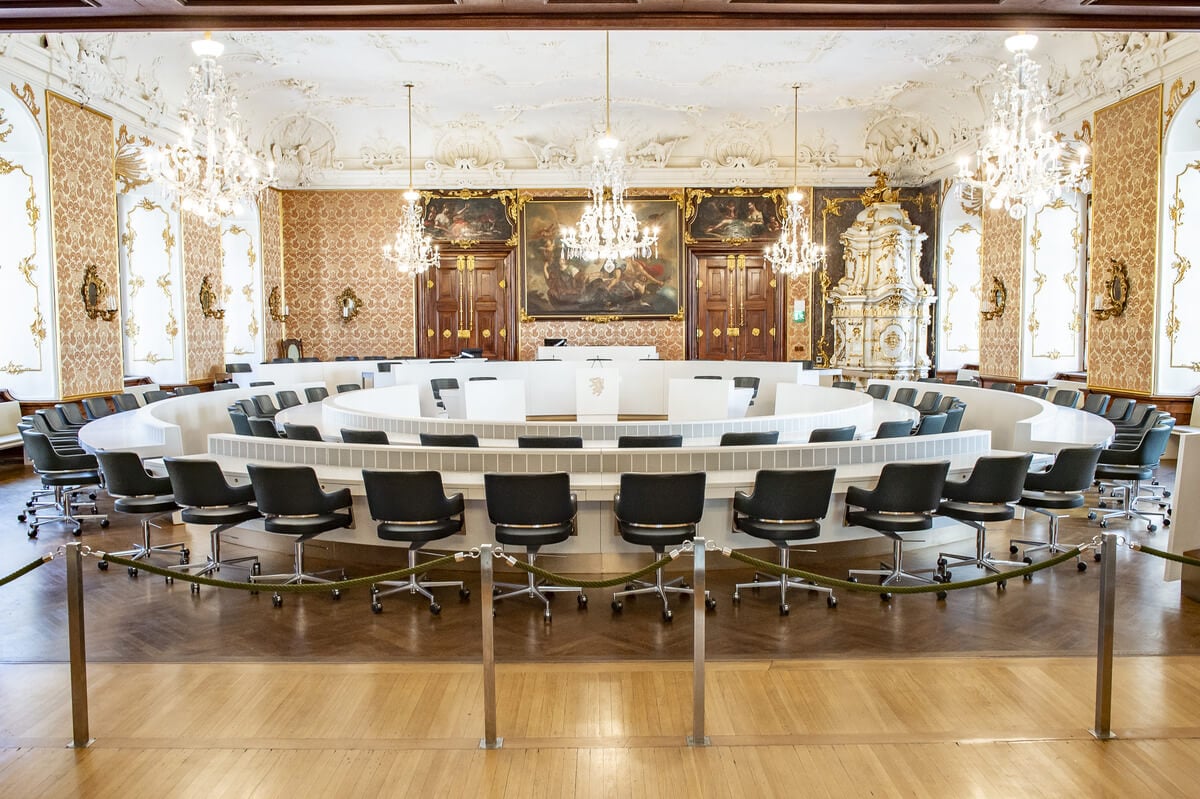
An interesting fact! The chapel and the black-and-gold altar were built in the early 17th century. The sculptural composition adorning the altar symbolizes the restoration of Catholicism in the city.
At the end of the 16th century, a law was passed prohibiting swearing, fighting, and displaying weapons in the parliamentary area.
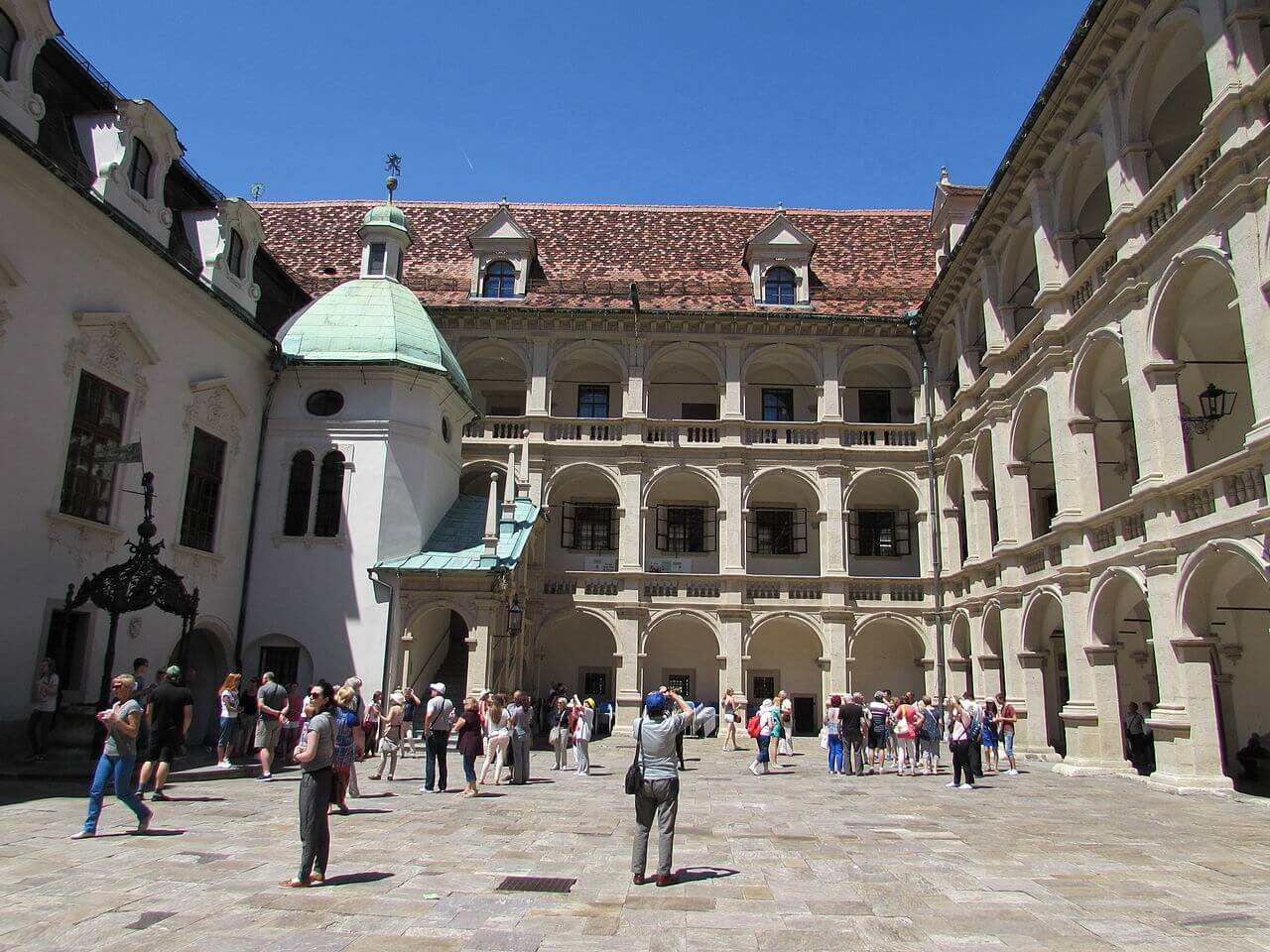
Before your trip, check out the sights of Graz on the Internet with photos and descriptions, and create a travel itinerary so that you don’t get distracted by organizational details.
Places to stay in Graz, Austria
The cost of accommodation in Graz, Austria, depends on the area. From a tourist perspective, it is best to choose accommodation near the city center.

- Innere Stadt, I – there is a large selection available, ranging from 45 to 250 euros.
- St. Leonhard, II – educational institutions are located here, but the student dormitories are of the highest class, so the area is quiet. Walking to the center takes no more than a quarter of an hour. The cost of accommodation varies from 60 to 150 euros.
- Geidorf, III is a student district. The advantages include a large number of cafes, restaurants, and coffee shops. However, it can be quite noisy. The cost of housing ranges from 55 to 105 euros.
- Jakomini, VI is a crowded area located near Jakomini Square, making it easy to get to any part of the city. There are many restaurants and cafes in the area, and visitors can also enjoy walking in the park. Accommodation options range from apartments and hotels, with prices starting at €49 and up to €195.

Most of the train stations are located in the right part of the city, which is why it is considered multicultural and has little resemblance to Austria. Tourists find it safer and more interesting to live in the left part of the city. If you are traveling by car and do not need to stay directly in the center, consider staying in the XI Mariatrost area. This is a green and picturesque neighborhood with many high-end homes and a beautiful church.
Do you want to save money on accommodation? You can stay in a student dormitory, but you need to check in advance to see if there are any available rooms. The cost of accommodation is 30 euros. You can also use the Couchsurfing system and stay with local residents for a nominal fee or even for free.
Food

Graz has many places where you can order traditional European dishes or try the Austrian menu. Prices vary depending on its status and prestige. A light snack will cost between 3.50 and 7 euros, and a full meal will cost between 8 and 30 euros per person.
How to save money on food:
- buy food in supermarkets and look for discounts in stores;
- The student way is to visit the gallery and buy snacks and juices. Similar events are held in Graz every day.
How to get from Vienna to Graz
The nearest airport is located 8 km from Graz, but there are no direct flights to Graz from the CIS countries, so many tourists find the city unattainable. Traveling by car will take too much time.
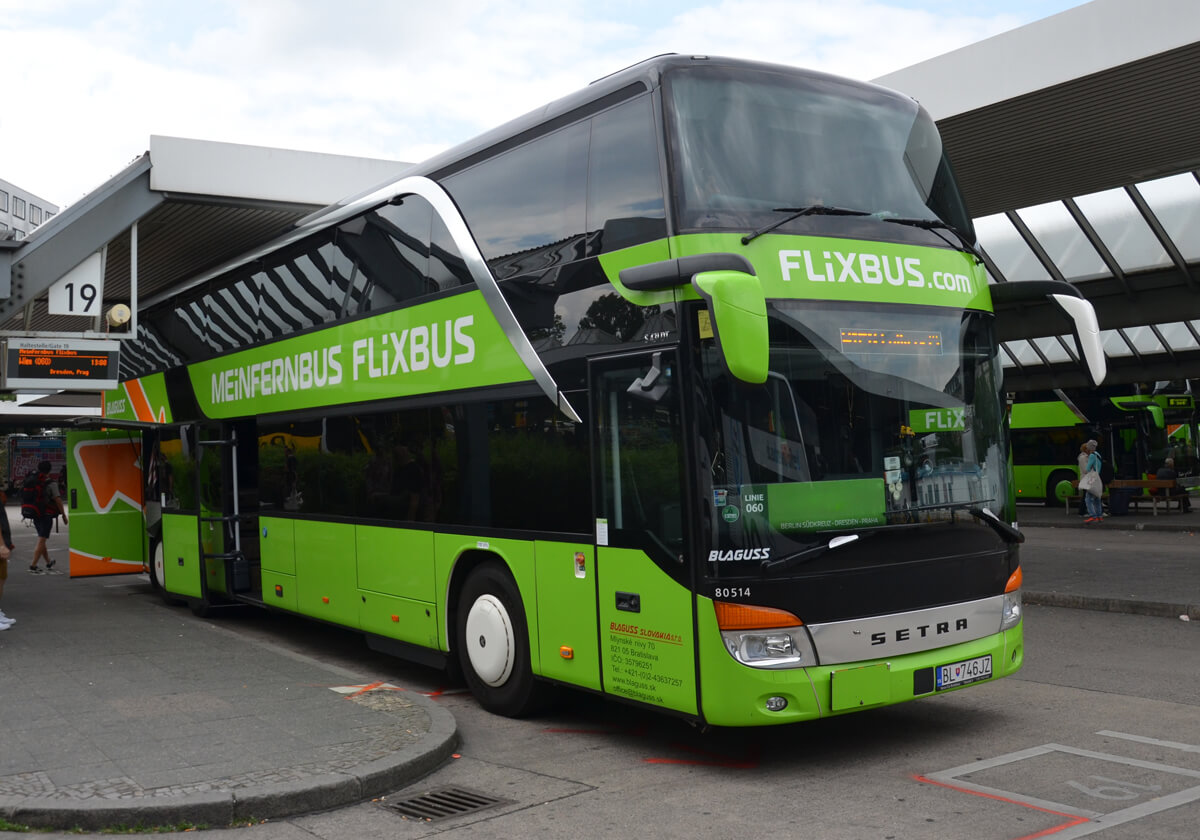
- The optimal route is with a transfer in the Austrian capital, where you can transfer to a comfortable bus of the carrier company Flixbus, following the route Vienna-Graz. Already in 2 hours, tourists are brought to Graz. The cost of the ticket depends on when you book it. The earlier you buy a ticket, the cheaper it will be, the minimum price is 8 EUR, it is important to save the document in the phone. For a child, you need to order a chair. Buses depart from three stations: Graz – Jakomoniplatz, Murpark, and Hauptbahnhof. In Graz, the transport arrives at the train station or Gigardigasse.
- Another option is to take a bus to Bremen and then a train to Graz, but this route is longer.
- There is a train route – take a train to Vienna, then change to a train to Graz, the flights depart from the central station every two hours. The ticket costs 24 EUR, the road takes 2.5 hours. The railway station is located on the outskirts of Graz, on Annenstrasse, where on a day off there is a fair.

There are three ways to get to Vienna by plane:
- direct flights last an average of two hours;
- If you take a connecting flight, you will spend about 5 hours on the road.
There are several ways to get from the airport in Graz to the city center:
- taxi – average cost of 45 EUR;
- bus number 630, 631 – ticket price 2.20 EUR, arrives at Jakominiplatz station;
- By train – the station is a 5-minute walk from the airport, the ticket costs 2.20 EUR and can be purchased in advance on the QBB website: tickets.oebb.at/en/ticket/travel. The journey takes only 12 minutes.
Useful tips

- Car rental offices are available in Graz, Austria. To rent a vehicle, you must have an international driver’s license and a bank card with the required security deposit.
- Taxis have an approved, unified fare system.
- The best way to make a call is from a payphone, which are located near all major stores and government offices. The cheapest call rates are from 8:00 a.m. to 6:00 p.m.
- Money can be exchanged at banks and post offices. Banks are open from 8:00 a.m. to 3:00 p.m., and only one day a week until 5:30 p.m. Weekends are Saturday and Sunday.
- Tipping is usually not required in restaurants, but if you enjoy the service, you can tip the waiter 5% of the bill.
- Stores open at 8:00 a.m. and close at 6:30 p.m., while large stores operate until 5:00 p.m.
- Cigarettes are expensive in Graz, and they are sold in special vending machines.
- The hottest month is August, when the temperature rises to +30 degrees Celsius.
Graz (Austria) is a city of amazing combinations. It has a strong sense of history, but at the same time, modern buildings are being actively constructed. Choose the perfect balance between sightseeing and leisurely walks, and enjoy your time in Austria by purchasing a traditional hat.

